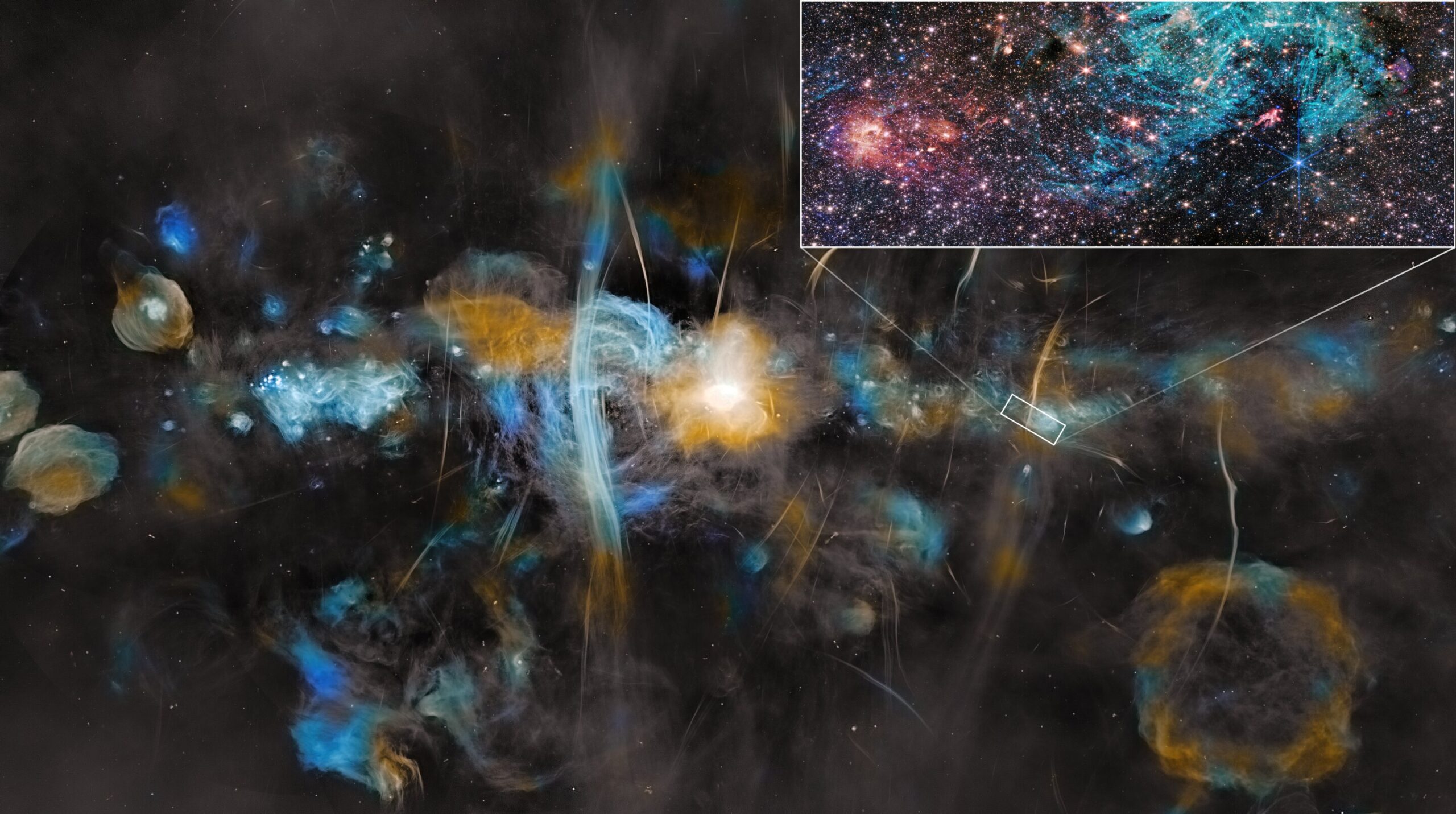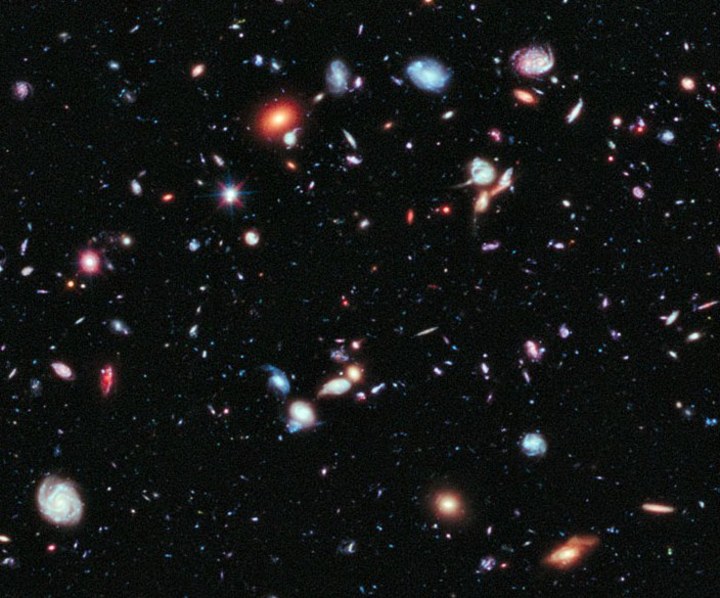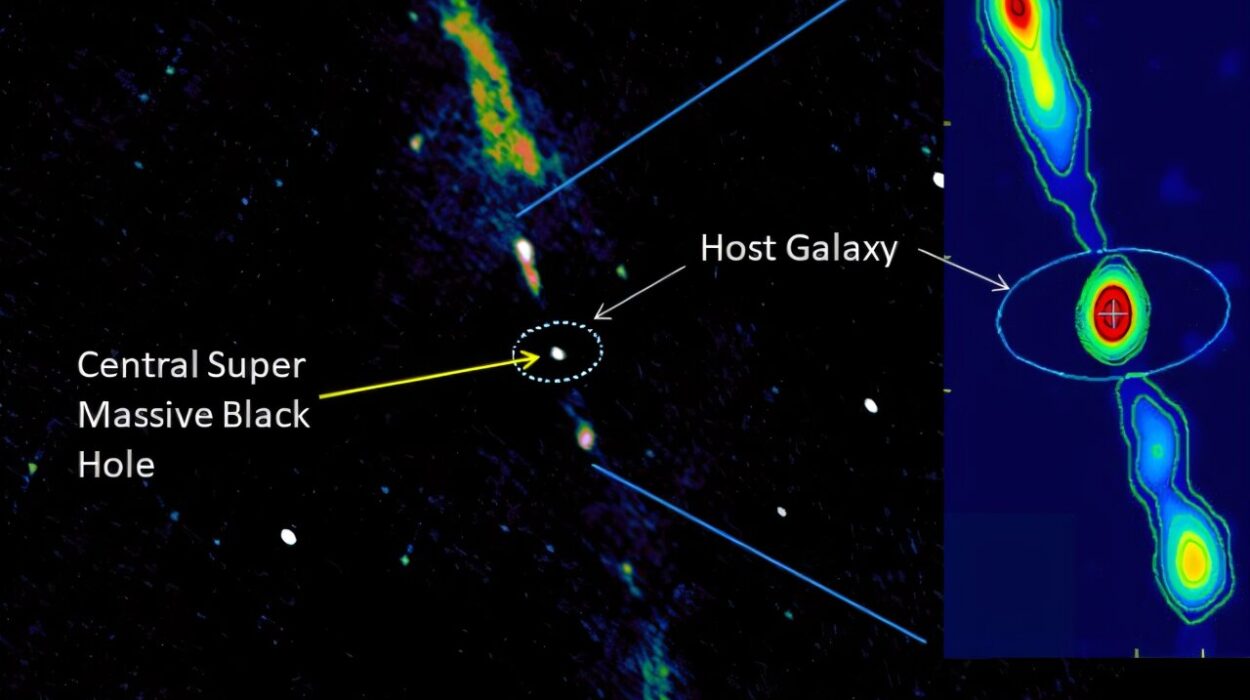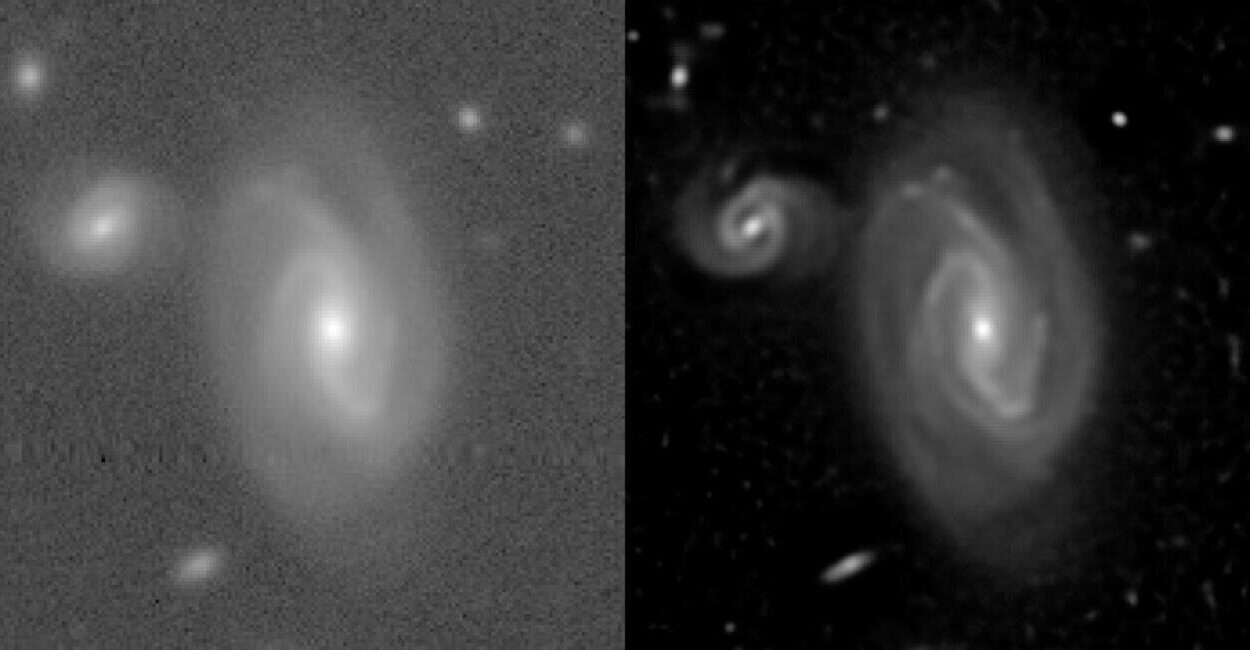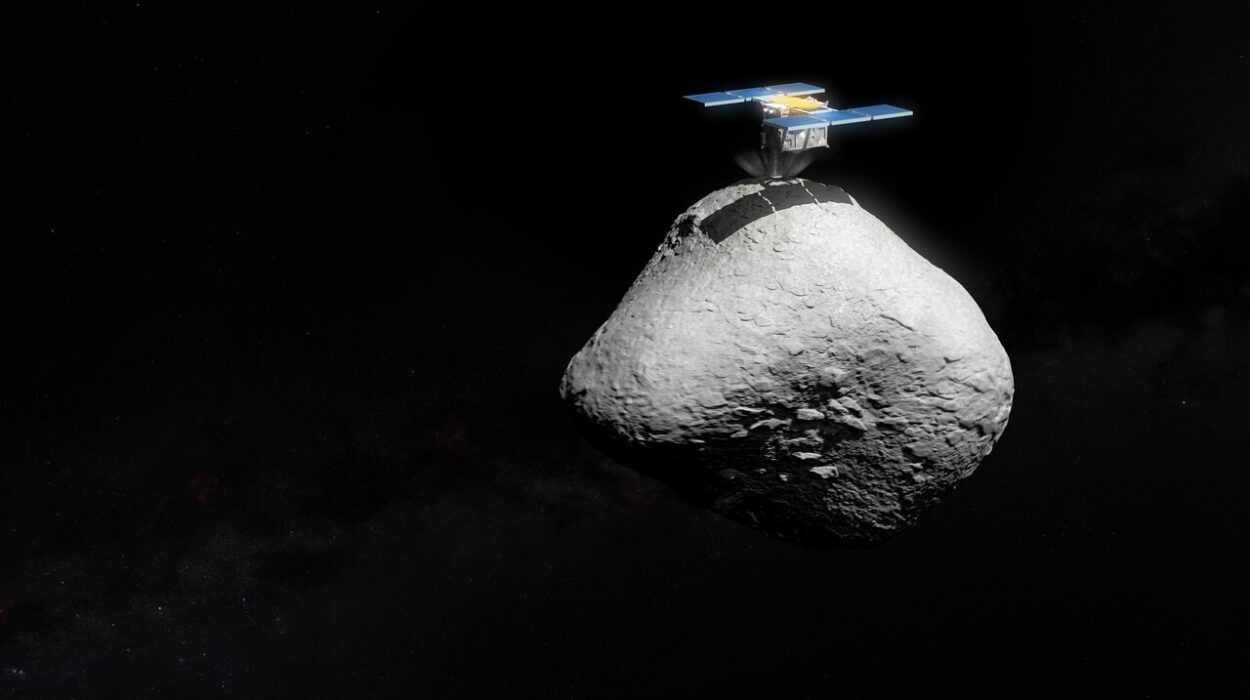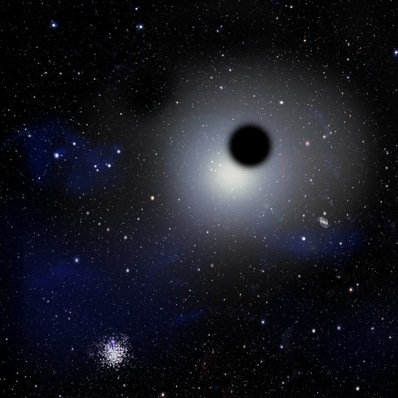In 2023, the James Webb Space Telescope (JWST) offered an unprecedented glimpse into one of the most enigmatic and dense regions of our Milky Way galaxy: the Sagittarius C stellar nursery, located in the heart of the Central Molecular Zone (CMZ). This region has long puzzled astronomers. Despite the presence of dense gas and cosmic dust—ingredients necessary for star formation—relatively few stars have been born here. Webb’s observations of this remarkable region, marked by intense radiation, powerful magnetic fields, and complex stellar dynamics, have provided groundbreaking insights into how stars form and why star formation might be suppressed in the galactic center.
The Mystery of Star Formation in the Galactic Center
The Central Molecular Zone of the Milky Way is a highly active and chaotic environment. Dense clouds of gas and dust in this region are often thought to be the birthplaces of new stars, yet only a few stars are formed here compared to other regions in the galaxy. As astrophysicist John Bally from the University of Colorado Boulder noted, “A big question in the Central Molecular Zone has been, if there is so much dense gas and cosmic dust here, and we know that stars form in such clouds, why are so few stars born here?”
Webb’s 2023 image of Sagittarius C—the brightest cluster in the central star-forming region of the galaxy—has helped answer this question. For the first time, scientists have observed strong magnetic fields potentially playing a crucial role in preventing star formation. As a key part of the study, these magnetic fields may suppress the collapse of dense gas clouds into stars, even at smaller scales within the region. The new research suggests that these magnetic forces might act as a “brake” on star formation, curbing the process despite the abundance of the raw materials needed for new stars to form.
Harnessing Webb’s Infrared Power
The key to unlocking the mysteries of Sagittarius C came from Webb’s infrared capabilities. The region is obscured by thick layers of dust that block much of the visible light, making it difficult to study through traditional telescopes. However, infrared light can penetrate through these cosmic dust clouds, revealing hidden stars and offering detailed views of their formation processes.
Webb’s advanced instruments—particularly its near-infrared spectrograph—allowed researchers to peer into the heart of this dusty region like never before. In particular, Webb’s observations confirmed earlier findings from the Atacama Large Millimeter Array (ALMA) that two massive stars are actively forming in Sagittarius C. Each of these stars has already accumulated more than 20 times the mass of the Sun. Webb’s infrared imaging also uncovered bright outflows powered by these protostars, which are expelling vast amounts of material into the surrounding gas cloud.
Despite the challenges, Webb also provided crucial information on low-mass protostars, which are typically harder to observe because they remain enshrouded in thick layers of dust. By comparing Webb’s data with previous observations from ALMA, the team identified five potential candidates for low-mass protostars—early-stage stars that are still gathering mass before beginning nuclear fusion. These protostars are a critical part of the star formation process and provide essential clues to understanding the range of star types born in different environments.

Ejecting Jets and Shocked Gas: New Star-Forming Insights
One of the most exciting findings from Webb’s observations is the identification of 88 features that appear to be shocked hydrogen gas. These features represent areas where the jets of material blasted out by young stars have collided with the surrounding gas, heating it up and causing it to glow brightly in infrared light. This phenomenon is a key signature of star formation, as it reveals the dynamic processes taking place within stellar nurseries.
The discovery of these shocked gas features led to the identification of a previously unknown star-forming cloud distinct from the main Sagittarius C cloud. This smaller, secondary cloud is hosting at least two protostars, each powering their own energetic jets. This finding adds an intriguing layer of complexity to our understanding of star formation in Sagittarius C and further underscores the importance of studying these regions in fine detail.
“Outflows from forming stars in Sagittarius C have been hinted at in past observations, but this is the first time we’ve been able to confirm them in infrared light. It’s very exciting to see, because there is still a lot we don’t know about star formation, especially in the Central Molecular Zone, and it’s so important to how the universe works,” said Samuel Crowe, a senior undergraduate at the University of Virginia and co-principal investigator on the research.
The Role of Magnetic Fields in Shaping Star Formation
Perhaps the most intriguing aspect of the 2023 Webb observations of Sagittarius C lies in the role of magnetic fields in shaping the environment of the galactic center. Webb’s detailed infrared image revealed a series of filaments—distinctive structures of hot hydrogen plasma—surrounding the main star-forming cloud. The researchers hypothesize that these filaments are being shaped by magnetic fields, which have been previously detected by other ground-based observatories like ALMA and MeerKAT.
The region surrounding the supermassive black hole at the center of our galaxy, Sagittarius A*, exerts extreme tidal forces on nearby gas and plasma. These forces likely stretch and amplify the magnetic fields in the region. As a result, the magnetic fields may exert a significant influence on the plasma, preventing it from dispersing and instead confining it into the tightly packed filaments observed by Webb. These magnetic forces could be strong enough to resist the gravitational collapse of gas clouds, which would typically lead to the formation of new stars. This could explain why star formation in Sagittarius C is lower than expected, despite the abundance of raw materials.
“The motion of gas swirling in the extreme tidal forces of the Milky Way’s supermassive black hole, Sagittarius A*, can stretch and amplify the surrounding magnetic fields. Those fields, in turn, are shaping the plasma in Sagittarius C,” explained Bally. The magnetic fields in this region may be acting as a powerful counterforce to the gravity that would normally cause gas clouds to collapse and form stars.
This new understanding of the interplay between magnetic fields and star formation is a significant breakthrough in astrophysics. While the effects of magnetic fields on star formation have been theorized for some time, this research provides strong evidence that these fields play a much more active role in shaping the stellar ecology of our galaxy than previously thought.
Implications for Star Formation Across the Universe
The implications of these findings extend far beyond the Milky Way. Understanding how magnetic fields influence star formation in the galactic center can help astronomers better understand similar processes in other galaxies. Many galaxies, particularly those with active galactic nuclei (AGN), host supermassive black holes and exhibit complex interactions between gas, dust, and magnetic fields. By studying regions like Sagittarius C, scientists can refine models of star formation in these extreme environments and apply them to other galaxies.
“This is an exciting area for future research, as the influence of strong magnetic fields, in the center of our galaxy or other galaxies, on stellar ecology has not been fully considered,” said Crowe. As the research team continues to analyze Webb’s data, they will undoubtedly uncover more mysteries about how stars form and why some regions of space seem to suppress the process.
Conclusion
The 2023 images and data from the James Webb Space Telescope have opened a new chapter in our understanding of star formation, especially in the extreme conditions of the galactic center. Webb’s infrared vision has allowed astronomers to peer through the cosmic dust and uncover new details about the formation of both massive and low-mass protostars in the Sagittarius C region. These findings also suggest that strong magnetic fields, amplified by the presence of the supermassive black hole Sagittarius A*, may play a key role in regulating star formation in this dense and turbulent part of our galaxy.
As researchers continue to analyze this groundbreaking data, it is clear that the environment around the galactic center is far more complex than previously imagined. The interactions between gravity, magnetic fields, and gas in this region may have broad implications for understanding the life cycle of stars in other galaxies, offering new insights into the processes that govern the universe’s most fundamental building blocks. With the help of Webb and future missions, astronomers will continue to explore the intricate and mysterious forces shaping the birth and evolution of stars across the cosmos.
References: Samuel Crowe et al, The JWST-NIRCam View of Sagittarius C. I. Massive Star Formation and Protostellar Outflows, The Astrophysical Journal (2025). DOI: 10.3847/1538-4357/ad8889. iopscience.iop.org/article/10. … 847/1538-4357/ad8889
John Bally et al,The JWST-NIRCam View of Sagittarius C. II. Evidence for Magnetically Dominated H ii Regions in the Central Molecular Zone, The Astrophysical Journal (2025). DOI: 10.3847/1538-4357/ad9d0b, iopscience.iop.org/article/10. … 847/1538-4357/ad9d0b
